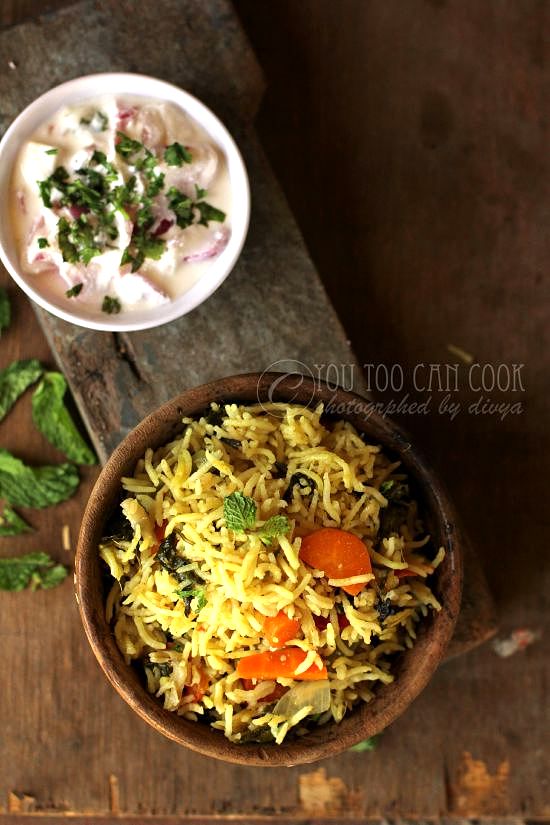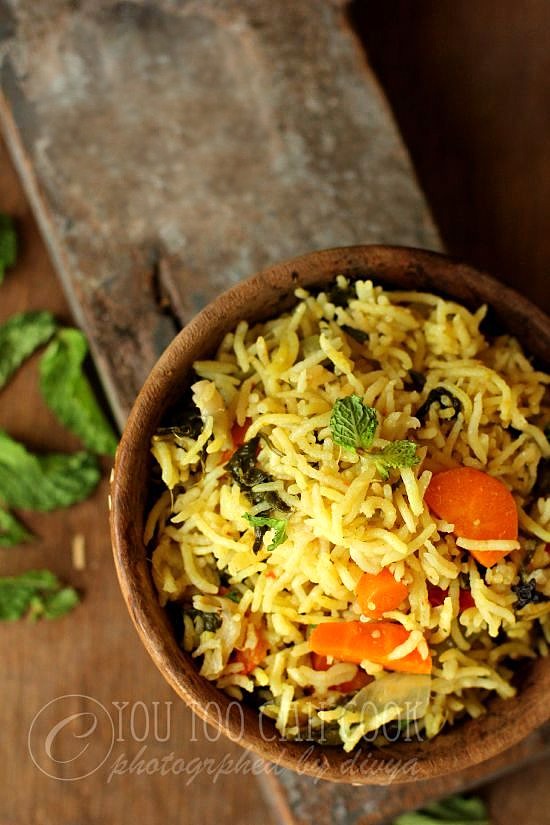Biryani, is one amongst the best known and very favorited Indian recipe around the world. Earlier biryanis where made only during a celebration or on any festive days it was prepared with the most richest spices and ingredients, but today it has been simplified to become an everyday meal. Here's on easy (almost) biryani which is one staple food at our home. This will make a great lunch box recipe too. I prefer making it in a pressure cooker as it is a mess free method is easier and yes, definitely saves considerable amount of time. Another notable reason is the rice becomes softer when pressure cooked and does not stay very grainy, a texture which we love back at home. When talking about biryani I rather make meat biryani than vegetable ones as vegetable biryani requires too much of work like peeling and chopping while the meat do not need such fuss. I have posted many biryani recipes which you can check here!

INGREDIENTS
Serves 5 to 6 peopleTotal Preparation Time - 40 minutes (depends on how fast you chop the veggies :P )
- Basmati rice - 400 grams
- Vegetables - 300 grams (Use a mix of carrots, peas, cauliflower, potatoes, french beans etc; I used carrots, baby corn and french beans)
- Soya chunks - 15 (optional)
- Onion - 4 or 5
- Tomato - 2
- Green chillies - 5
- Lemon - 1
- Mint leaves and Coriander Leaves - 50 grams
- Coriander powder - 3 teaspoons
- Cumin powder - 2 teaspoons
- Garam masala - 1/2 teaspoon
- Turmeric powder - 1/4 teaspoon (Just for the color)
- Salt - 2.5 teaspoons
- Fennel seeds - 1 tablespoon
- Cloves - 8
- Star anise - 3
- Bay leaf - 2
- Green cardamom pods - 12
- Cinnamon stick - 5 two inch long sticks
- Kalpasi / Black stone flower - 2 small pieces (optional)
- Cashew nuts - 10 (optional)
- Oil - 100 to 150 ml (or 50 ml ghee and + 100 ml oil)
- Water - 1000 ml (one litre)

PREPARATION METHOD
- Wash and soak basmati rice in water for 10 to 20 minutes.
- Wash, peel and chop all the veggies into medium sized cubes or pieces. Wash and chop coriander leaves, I use the tender stems too, then wash pluck the mint leaves.
- If using coconut milk, take half of a coconut and chop into smaller pieces, grind well by adding some water. Then pour 200 ml of water mix and pour through a thin cloth or sieve extract the milk set aside. Discard the coconut pulp.
- If using soya chunks follow this method to clean and use in the recipe.
- Place a cooker on flame and pour oil into it. After it heats up, add Fennel seeds, cloves, cardamom pods, star anise, bay leaves, cinnamon sticks, kalpasi and saute for a few seconds. Do not let it burn.
- Then add slit green chillies, sliced onion, cashews (if using) and saute until onions seem half cooked. Then add cubed tomatoes, ginger garlic paste and saute until raw smell leaves.
- Now add the mint and coriander leaves and saute until the leaves shrinks.
- Add garam masala, cumin powder, coriander powder, turmeric powder, salt and saute. (You can add 3 teaspoons of red chilli powder if you want the biryani to be spicier)
- Now add the chopped vegetables (soaked soya chunks if using) and give a good stir so that it gets mixed up well with the masala.
- Then drain water and add the soaked basmati rice. Stir gently so that the rice grains do not break.
- Pour one litre of water. (Use the same cup to measure rice and water; water : rice ratio should be 2:1) If using coconut milk add 500 ml coconut milk and 500 ml water.
- Squeeze and pour lemon juice and stir.
- Check for salt, add if needed.
- Cover with the cooker lid and switch to high flame. Wait until the steam oozes out and then place the regulator or weight and cook on low flame for 10 minutes.
- Then remove from flame and set aside undisturbed until the pressure drops.
- Then open the cooker and serve hot with raita.

TIP 1: You can add different vegetables of your choice, but make sure not to dump with too much of vegetables. Mushrooms, beetroots, cauliflower, butterbeans, broccoli, baby corn, potato, baby potato etc can be used. If using 400 grams rice use 300 to 400 grams vegetables not more than that.
TIP 2: You can also make with other rice varieties but basmati rice suits the dish well. Soaking basmati will give a better texture, the rice will stay non-sticky and soft for a long time. But you can cook even without soaking.










Love it... Nice space u have...
ReplyDeletehttp://recipe-excavator.blogspot.com
hi divya
ReplyDeletei tried this receipe.it was so good.
Thanks Meena :) Hope you enjoyed it!!
DeleteHi,
ReplyDeleteAll your recipes are too good and different:-). I just have a doubt on ur rice varietIRS, each dish you use the rice and water measurementment differently. Is it 1:1.5 or 1:2 rice and water ratio? Plz do let me know which to follow.
Thanks in advance,
Diya
Hi Diya :)
ReplyDeleteThanks for the appreciations... Yeah the ratio differs depending on the rice you use for cooking and also on the texture you need. If you want to make a variety rice with basmati its well and good that you use 1:2 ratio after soaking it in water for 15 minutes.. I use this 1:2 ratio commonly. The 1:5 ratio gives you the grainy and 3/4th done rice but the 1:2 ratio gives a better cooked and slightly grainy rice. 1:5 ratio can be used for pulao, fried rice and dum biryani, depending on the texture you need. If you are using normal rice that you use for everyday cooking the ratio differs, but the most common ratio is 1:2.5 but it purely depends on the type of rice, if its too old the rice might need 1:3, always prior soaking helps reduce the cooking time, and amount of water needed to cook.
So it purely depends on the texture you need my advice is go for 1:2 to get a well cooked rice or 1:1.5 to get a grainier rice.
Thanks :)
Hi Divya,
ReplyDeleteThanks a lot for the quick reply.
You say 1:2 is good for pulao and Briyani. yeah tats well. But soaking rice and keeping water for 1:2 doesn't make the rice mushy? I got few queries, can u plz clear me up.
1. Is it the case that if rice is soaked, the ratio for rice: water is 1.5(1:1/2) else its 1:2.
2. And do we need to fry the rice only when soaked
3. How many whistles/simmer in mints required, for the rice to be well grained, does it differs based on soaking or not of the rice.
4. And as regards of the dum, can we make dum kinda rice in pressure cooker
can u plz clear me up ;-)
Thanks,
Diya
Hi Diya :)
DeleteMy pleasure, No the rice doesnt turn mushy, but its not very grainy too, I hope you understand, a graniy rice is the one used for fried rice. 1:2 ratio gives a better cooked rice, you can see the above pic I have used 1:2 ratio but still the rice is grainy not very sticky but cooked to perfection. Reg your queries;
1. The 1:1.5 (sorry for the typos, 1:5 is 1:1.5) is what I recommend for fried rice, pulao and dum biryani. As you can see it definitely needs such kind of texture.
2. Yes only after soaking you must fry the rice, this helps your rice get well cooked and frying makes it grainy.
3. Totally 10 minutes. 5 to 7 simmering minutes will do. Keep the cooker on high flame until pressure oozes out then place the regulator or whistle and switch to low flame and cook for 5 to 7 minutes. and after switching off the flame just keep the cooker aside until pressure drops this by itself is a dum procedure. (hope this answers your 4th query too)
Thanks
Hi Divya,
ReplyDeleteSo many thanks :-). It's very sweet of you to answer my queries & clarify it. For sure I try your recipes & update you. Thank you once again :-)
Thanks,
Diya
Hi Divya,
ReplyDeleteYou have got a good number of collections. I tried your capsicum briyani/rice it came out very well. Thank you so much !
Actually I had a doubt later on when I saw your Briyani recipe. I read Diya questions and your answers,it was very clear. Just I need one clarification, you have mentioned in your answer that we can do rice: water ratio either 1:1.5 or 1:2. For that both method rice to be soaked for 15 mins right?
Then is it that if using ratio 1:1.5 after pressure we have to keep it in 5 mins in low then switch off, and of using 1:2 ratio we have to keep in Sim for 10 mins then off it? (because i see a difference ratio in ghee rice too)
So just got confused. Hope u understand my question.
Thanks,
Sandy
When do you add 14 thro 18?
ReplyDeleteThanks.